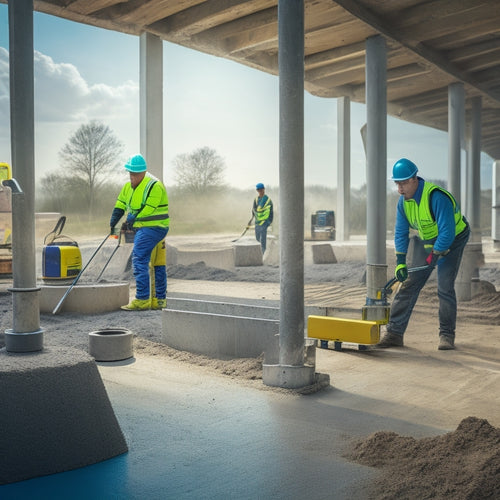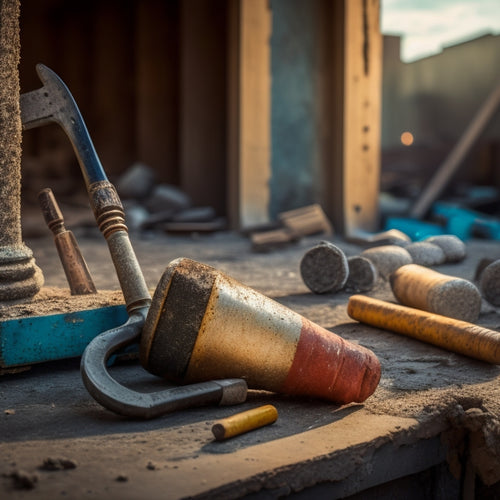
Top Tools for Grinding Concrete Blocks Effectively
Share
When it comes to grinding concrete blocks effectively, you need the right tools for the job. You'll want to identify your specific grinding needs, considering factors like block material, size, and desired surface finish. Then, choose between handheld or walk-behind grinders, electric or gas-powered models, and consider ergonomic design, dust collection, and safety features. With so many options available, it is important to evaluate power sources, handling, and budget considerations to make an informed decision. By understanding these key factors, you'll be well on your way to selecting the perfect tools for your concrete block grinding project, and finding the best solutions for your unique needs.
Key Takeaways
• Identify project scope and specific grinding requirements to choose the right tool for the job.
• Select the appropriate grinder type based on concrete block material, size, and desired surface finish.
• Consider power source options, energy efficiency, and ergonomic design for optimal performance and operator comfort.
• Ensure reliable dust collection systems and safety features to minimize health risks and promote a safe working environment.
• Evaluate brand reputation, user reviews, and cost-effectiveness to make an informed decision when choosing a grinding tool.
Identify Your Grinding Needs
To determine the best tool for grinding concrete blocks, you need to define the scope of your project and identify the specific grinding requirements. This involves evaluating the block materials, their size, and the surface finish you want to achieve.
Are you working with dense, abrasive blocks or softer, more porous ones? Do you need to remove old adhesives, roughen the surface, or achieve a high-gloss finish? The answers to these questions will influence your choice of grinding techniques and tools.
Consider the scale of your project too. Are you working on a small, DIY project or a large-scale construction site? This will impact the power and capacity of the tool you need.
You may require a handheld grinder for precision work or a walk-behind grinder for larger areas. By understanding your specific grinding needs, you can select the most suitable tool for the job, ensuring efficient and effective grinding results.
Types of Concrete Blocks Matter
You'll encounter different types of concrete blocks, each with its unique characteristics, which greatly impact the grinding process and tool selection. The block composition, in particular, plays a vital role in determining the most effective grinding techniques.
For instance, solid concrete blocks with a dense aggregate require more aggressive grinding methods, whereas hollow blocks with a lower density can be ground using less intense techniques.
The type of aggregate used in the block composition also affects the grinding process. Blocks containing hard aggregates like quartz or granite demand more robust grinding tools, whereas those with softer aggregates like limestone can be ground with lighter-duty tools.
Additionally, the block's surface texture and finish can influence the grinding process. Smooth blocks require a more precise grinding approach, while rough-textured blocks can be ground using more aggressive methods.
Understanding the characteristics of the concrete blocks you're working with is essential for selecting the right grinding tools and techniques. By considering the block composition and surface texture, you can optimize your grinding process, achieve better results, and reduce the risk of damage to the blocks or the grinding tools.
Power Source and Energy Efficiency
When selecting a grinder for concrete blocks, you'll need to evaluate the power source that best suits your needs.
Will you opt for an electric grinder, which offers reliability and reduced maintenance, or a gas-powered model, which provides increased portability?
As you weigh these options, don't forget to look for energy-saving features that can help minimize your environmental impact and reduce operating costs.
Electric Vs. Gas
Grinding concrete blocks efficiently relies on choosing the right power source, with electric and gas options presenting distinct advantages regarding energy efficiency and performance.
As you weigh your options, it's crucial to evaluate the performance comparison between electric and gas-powered grinders.
Electric grinders are ideal for smaller, more precise tasks and offer a quieter operation, making them suitable for indoor application scenarios. They're also more environmentally friendly and require less maintenance.
On the other hand, gas-powered grinders are better suited for heavy-duty, large-scale projects that demand high torque and power. They're perfect for outdoor applications where noise isn't a concern. However, they're noisier, produce emissions, and require more maintenance.
When deciding between electric and gas, you should reflect on the scope of your project, the type of concrete you're working with, and your personal preferences.
Energy Saving Features
Your concrete block grinding efficiency relies heavily on the power source's energy-saving features, which not only reduce your environmental footprint but also lower operating costs. When selecting a tool, look for energy conservation features that minimize energy waste and optimize performance.
Modern grinders often boast advanced motor designs and smart sensors that detect and adjust to changing load conditions, ensuring maximum efficiency. Additionally, some models incorporate regenerative braking, which captures and reuses kinetic energy, further reducing energy consumption.
Efficiency advancements in grinder design also play an essential role in energy conservation. For instance, some tools feature optimized gearbox designs that reduce energy losses and improve overall efficiency. Others utilize advanced bearing systems that minimize friction and heat buildup, resulting in lower energy consumption and extended tool lifespan.
Handling and Ergonomic Design
When you're grinding concrete blocks, you need a tool that fits comfortably in your hand and allows for precise control.
You'll want to look for grip and control options that reduce slippage and strain, ensuring you can work efficiently without sacrificing safety.
Grip and Control Options
Concrete block grinders' ergonomic design plays a significant role in reducing operator fatigue, as a comfortable grip and intuitive control layout enable you to work efficiently for extended periods.
A well-designed grip is essential, as it directly affects your control over the tool. Look for grip materials that provide a secure hold, even with gloved hands or in wet conditions. Rubberized grips or those with textured surfaces are excellent options.
The control mechanisms should be strategically placed to minimize strain on your hands and wrists. You'll want to take into account grinders with adjustable handles or pivoting heads that allow you to maintain a comfortable stance while working.
Some models feature variable speed controls or trigger locks, which can further reduce fatigue.
When selecting a concrete block grinder, prioritize grip and control options that fit your work style. By doing so, you'll be able to tackle demanding projects with confidence and precision.
Reduced Fatigue Features
Beyond a comfortable grip and intuitive control layout, you'll want to focus on the handling and ergonomic design of your concrete block grinder, as these reduced fatigue features can greatly impact your productivity and overall work experience.
A well-designed grinder should prioritize user comfort, ensuring you can work for extended periods without exhaustion. Look for a tool with a balanced weight distribution, allowing you to maneuver it effortlessly. A grinder that's too heavy can lead to fatigue, compromising your accuracy and efficiency.
Opt for a grinder with an ergonomic design that fits comfortably in your hand, reducing strain on your wrists and arms. This will enable you to maintain a steady grip, even during prolonged use.
Additionally, consider a grinder with adjustable handles or grips, allowing you to customize the fit to your preferences. By prioritizing handling and ergonomic design, you'll be able to work longer, smarter, and more efficiently, ultimately achieving better results and reducing the risk of injury.
Dust Collection and Safety Features
You'll need a reliable dust collection system to minimize airborne particles and prevent hazardous breathing conditions when grinding concrete blocks. This is vital because concrete dust can cause serious health issues, such as silicosis and lung cancer, if inhaled excessively.
To achieve effective dust suppression, you'll want to employ dust suppression techniques like wet grinding or using a vacuum-equipped grinder. Additionally, you must wear personal protective equipment (PPE) like respirators, safety glasses, and dust masks to prevent inhalation of airborne particles.
When selecting a dust collection system, look for one that's specifically designed for concrete grinding. These systems typically consist of a vacuum, hose, and filter, which work together to capture and contain dust particles.
Make sure the system is compatible with your grinder and can handle the volume of dust generated during the grinding process. Remember, a reliable dust collection system is fundamental to maintaining a safe and healthy work environment.
Budget and Cost-Effectiveness Analysis
As you've guaranteed a safe and healthy work environment by prioritizing dust collection and safety features, now it's time to balance your budget by evaluating the cost-effectiveness of various grinding tools and techniques for concrete blocks.
It's essential to perform a thorough cost comparison of different options, considering factors such as the initial purchase price, maintenance costs, and operating expenses. You should also assess the cost per unit of material removed, as well as the tool's lifespan and replacement costs.
Within your budget constraints, you'll need to weigh the benefits of investing in high-end grinding tools against the potential savings of opting for more affordable alternatives.
Consider the trade-offs between tool longevity, performance, and price. For instance, a higher-priced grinder might offer superior performance and longer lifespan, but may not be feasible within your current budget.
Brand Reputation and User Reviews
When evaluating grinding tools for concrete blocks, considering the reputation of manufacturers and the feedback from users who've operated these tools in real-world applications helps you separate high-performing products from those that fall short. A manufacturer's brand reputation is built on its ability to deliver consistent quality, reliability, and performance. You should look for brands that have earned a reputation for excellence in the industry.
| Brand | User Review Rating (out of 5) |
|---|---|
| Bosch | 4.5 |
| DeWalt | 4.8 |
| Makita | 4.2 |
| Hitachi | 4.6 |
You should also investigate user reviews to get a sense of the actual user experiences with the tools. Pay attention to comments about the tool's performance, durability, and ease of use. This will give you a better understanding of how the tool will perform in your specific application. By considering brand reputation and user reviews, you can make an informed decision and choose a grinding tool that meets your needs. This will help you build brand loyalty and guarantee that you're getting the best value for your investment.
Frequently Asked Questions
Can I Use a Concrete Grinder for Polishing Concrete Floors?
You're wondering if you can use a concrete grinder for polishing concrete floors. The answer is yes, but with caution.
A concrete grinder is ideal for preparing the floor for polishing, but it's not designed for the final polishing stages.
You'll need to switch to specialized polishing techniques and equipment to achieve the desired floor finishes.
Don't skip this step, as it's essential for a high-gloss finish.
Are Concrete Grinders Suitable for Grinding Asphalt or Blacktop?
As you venture into the world of grinding, you're faced with an essential question: can concrete grinders tackle asphalt or blacktop?
The answer is a resounding no. These machines are designed for concrete, not asphalt grinding or blacktop resurfacing.
Asphalt's unique composition requires specialized tools to prevent damage and guarantee a smooth finish.
Don't risk compromising your equipment or the job - choose the right tool for the task to achieve professional results.
How Often Should I Replace the Grinding Wheel or Sanding Disc?
You should replace your grinding wheel or sanding disc regularly to maintain peak performance.
The grinding wheel lifespan depends on usage, but typically lasts between 10 to 20 hours.
For sanding disc maintenance, inspect for wear every 5 hours and replace when worn down to 1/8 inch.
Keep track of usage hours and visual signs of wear to guarantee you're getting the best results from your tools.
Can I Rent a Concrete Grinder Instead of Buying One?
When considering a concrete grinder, you're probably weighing the pros and cons of renting versus buying.
A cost comparison is essential here. Renting can be a cost-effective option, especially for small projects or infrequent use. You'll avoid the upfront purchase price and maintenance costs.
Plus, rental benefits include access to specialized equipment and the latest technology without the long-term commitment.
Are Concrete Grinders Only Used for Grinding Concrete Blocks?
Did you know that 75% of construction projects involve concrete surface preparation?
Now, are concrete grinders only used for grinding concrete blocks? Not quite!
You'll find various concrete grinder types, each designed for specific tasks. While they're often used for block grinding, they're also essential for preparing concrete surfaces for coatings, overlays, or repairs.
In fact, concrete grinders are an important step in achieving a smooth, even finish.
Conclusion
You've finally made it to the end of this concrete-block-grinding journey.
Ironically, the most important tool you've acquired isn't a grinder or a polisher, but a deeper understanding of what makes a great concrete block grinder.
With your newfound knowledge, you're ready to tackle even the toughest blocks with ease and efficiency.
Remember, it's not just about grinding concrete; it's about doing it with precision, safety, and style.
Related Posts
-

Top Tools for Mixing Concrete at Home
When mixing concrete at home, you'll need a range of tools to guarantee a successful operation. Start with essential ...
-

What Tools Ensure Precise Concrete Leveling Results
You need a range of specialized tools to achieve precise concrete leveling results. Laser leveling instruments provid...
-

5 Tips for Splitting Concrete With Second-Hand Tools
When splitting concrete with second-hand tools, you'll need to be strategic to avoid wasting time, money, and putting...


